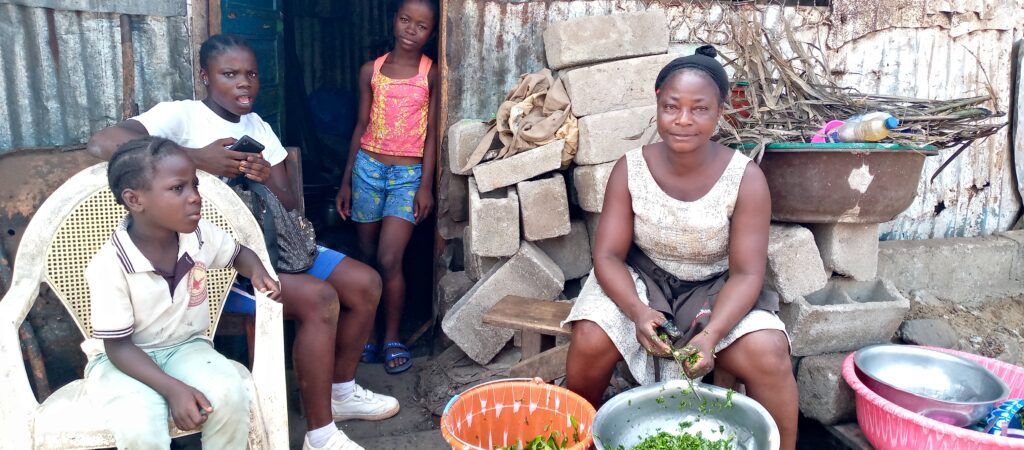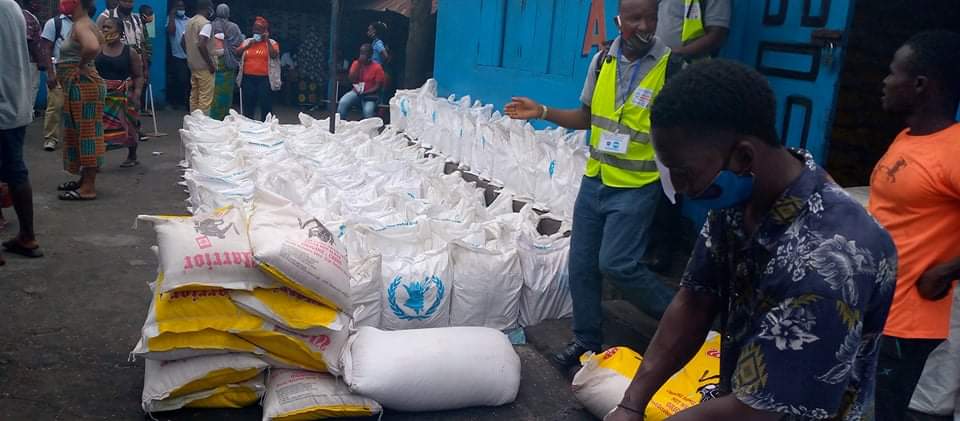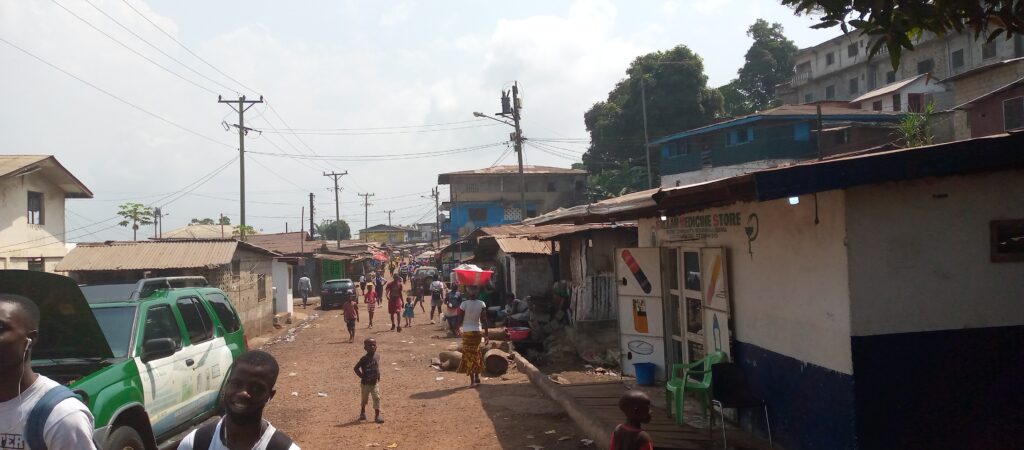Liberia feeding the poor: Monrovia residents still wait for COVID-19 food relief

Months after a programme to provide food for the poor under a COVID-19 food relief effort had started, some residents of Monrovia are still waiting for their rations. The Liberian government had allocated an amount of $25 million to provide food relief for the poor and vulnerable.
The coronavirus pandemic first hit Liberia in March of 2020. Patient Zero was a government official, who had traveled by air from Switzerland to Liberia on government business. Mr Nathaniel Blama, headed the Environmental Protection Agency (EPA) until he was dismissed by the president of Liberia, George M. Weah for an alleged act of fraud in August of 2020.
In response to addressing the pandemic, President Weah announced a food relief programme, the government’s intervention to assist poor and vulnerable citizens to keep safe, contain the virus and work to return the country to normalcy. The programme was presented to the Liberian Senate in October 2020. The World Food Program (WFP) and the Liberia Institute of Statistics and Geo-information Services-LISGIS were chosen to coordinate the food distribution.
According to the Government of Liberia COVID-19 Household Food Supply Program Summary Report on Implementation prepared by the WFP, the programme was to start by providing food relief to 500,000 vulnerable households or 2.5 million people including welfare institutions and frontline workers. Each household was to receive 50kg rice, 10kg beans and 4.5kg vegetable oil; an estimated total of 32,365 metric tons of food commodities. But our investigation has found that a good number of those vulnerable households did not benefit.
Speaking to the issue, the WFP Head of Programmes, Amos Ballayan says the Government of Liberia food assistance programme specifically was meant to target 2.5 million Liberians out of 5 million. He also said the WFP had to deal with beneficiaries in such a way that they [WFP] would be able to pick up the most vulnerable from among the vulnerable.
“There is no way we can do food distribution for 2.5 million people out of 5 million without targeting; it’s that targeting approach that we used that made some people to be qualified and some people to not,” he disclosed
During investigations, we found that West Point, a slum Community in central Monrovia, was one of the communities that benefitted fully from the programme. All the community members we talked to said they received their fair ration of the food.
But like Bassa community, not all the residents of Buzzy Quarter-UN Drive and Jallah Town community claimed to have received their ration.
From first-hand accounts from residents, we further found that even the people who benefited in the Bassa Community on the Capitol By-pass did not receive their fair ration of food.
Hawa Cole, 44, sat on a wooden bench chopping some vegetables or greens as it is called in Liberia. She sat right on the streets by what served as her home. A building made from old zinc sheets that looked unsafe for the middle-aged woman and her children.
The structure sat right beside a drain just a step away from the Slipway Community main street. Hawa is a single mother of four girls, all of them below the age of 18 years. The girls had just returned from school as I was speaking with their mother.
Hawa and her children survive on what she earns from selling cooked food also known as ‘cold bowl’.
Narrating her experience about how the food distribution was done in her community, she was not happy, she said. She pointed out that her home was one of the structures pre-marked by enumerators yet she didn’t benefit from the food.
“They didn’t give me any food. They refused to give me food because according to them, my name was not on the list; even on the day of the distribution, I told them to check on the list for my name, they refused and that was how I got tired of it,” Hawa said.
When asked if her house was pre-marked by the enumerators from LISGIS, she said it was done twice by different groups of enumerators.
“My house was marked first but another group came and rejected the first mark and they told me that it wasn’t the right people who marked my house,” she said.
To gather more facts, one of the four block leaders of the Slipway Community working along with the enumerators, T. Mac Luther Johnson, accompanied the team from LISGIS in his assigned area of the community aiding them in the process of enumeration.
“I observed that they were collecting and storing data directly on a mobile device (smartphone) and they were also experiencing issues with the GPS device on the phone because they complained that it was slow at times and all that,” Johnson explained.
He, however, pointed out that often, the enumerators from LISGIS complained that they were running out of time and if the devices did not capture some information on time, they would leave and move to another person or house.
“It seems that they were impatient or somehow they were not properly trained on how to collect the data effectively, because I too was a victim of that because my name was not captured on the final list,” Johnson said.

Like other communities in Liberia, Slipway, which is a slum, has a Community chairman. Seeking to establish why some of the community members did not benefit from the food distribution, I spoke to Lasana Sannor.
Lasana firstly acknowledged that the community benefited from the COVID-19 food distribution but he thought that the process was challenging because the enumerators from LISGIS initially refused to work with the community leadership.
“I believe that people who didn’t live in Slipway pretended to be residents of the community and didn’t show up when their names were called. We even tried reaching out to some of them and they told us they were elsewhere,” he added.
According to him, authorities in charge of the distribution remained in the community for about two days to give the community members who were absent more time to pick up their rations.
“When some of the people on the record had picked up their food, the distributors had to pack up the remaining food and leave even though they had names still on the record who didn’t show up at all,” he said.
When asked about the case of Hawa from Slipway who happened to be in the most vulnerable category and yet didn’t benefit, the WFP Head of Programmes, Mr. Ballayan explained that every house registered in the Slipway community was supposed to get food.
“Our analysis of places like Slipway was that it is a slum and we said that any slum community we register, everybody should get food,” he stated
Meanwhile Ballayan disclosed that the entire Slipway community was eligible to benefit from the process and if because of an error some people did not benefit, then there’s a need for a deeper investigation to ascertain the root cause of the problem.
“In Slipway, we were not segregating between vulnerable and non-vulnerable, we were taking everybody because we declared Slipway as a slum,” explained Ballayan.
Speaking to the issue of why some houses were marked twice, Ballayan said it happened that way either because there was nobody at a particular household at the time the enumerator came around or basically an oversight.
“When we do enumeration, we do what we call, call-back; when we went for the enumeration there were a lot of people who were not at home,” explained Ballayan.
He continued: “government instructions were that every household must be marked, so we take note of the structure, they give it a mark then we pass.”
Ballayan also indicated that if there was only one household present at the time of enumeration in a particular structure and the others residing in said structure were absent, the enumerators would only take the information of just the single household.
“If a community had many such cases or it was data error from data entry, a call-back would have to be done in the affected community,” he said.
Further looking into the matter, we found that even though surrounding communities around Monrovia, like parts of Airfield and Old Road areas, Hammond Field-Duport Road, Zayzay community, Paynesville, were pre-marked and data collected, but food distribution wasn’t done.
When asked about the present status of the food assistance programme, Ballayan said his team is almost at the verge of completing Montserrado, the County that hosts Liberia’s Capital City, Monrovia.
He added that apart from the distribution in Montserrado, his team is also in 11 other Counties of Liberia doing the same work.
“We are hoping to complete the 15 Counties by the end of February 2021,” he added.
He noted that the last recipients of the food assistance in Montserrado will include a few communities in Somalia Drive, Rural Montserrado-Harrisburg, St Paul River District and the 540 area in Congo Town.
“We were given a total of one hundred and seventy-three thousand (173,000) households to serve in Montserrado and we have already reached a total of 150,000,” said Ballayan

In his State of the Nation Address (SONA), President Weah on January 22, 2021 highlighted that Liberia has not been spared by the coronavirus pandemic.
He said: Liberia recorded its first case in March 2020 and as of today’s date we have confirmed 1,927 total cases with 1,722 recoveries and 109 active cases. We have also recorded 84 deaths, with only 13 deaths occurring in treatment centers.
The President acknowledged the difficult circumstances.
“During the year under review and in response to COVID-19, the National Legislature approved in April 2020 a State of Emergency and provided stimulus package support as part of the national budget; an amount of $25 million was also approved….”
LISGIS declined to respond to queries on this subject when contacted.
When asked why authorities from LISGIS refused to comment, Ballayan explained that it happened that way probably because the WFP ended its contract with LISGIS in October or so in 2020.
The WFP Programmes head explained further that some of the residents didn’t benefit from the programme because they didn’t register.
“There were some communities that LISGIS went in to register and people didn’t believe in this process,” Ballayan said.
Ballayan explained: “So we had a situation where, if somebody did not register at all it was difficult to give that person food,”
When asked about people who claim their houses were marked and their information was taken by the enumerators from LISGIS but their names were not reflected on the log, Ballayan stressed that it was difficult to prove or disprove the claims of community members.
“If somehow by error somebody got omitted that would be difficult for me to tell; while we were on the field people who came and said we were registered and we didn’t see our names, and most times we didn’t find it, we couldn’t prove that they did register,” he said.
By Alline Dunbar
This report was produced with the support of CENOZO within the framework of the project “COVID-19 Response in Africa: Together for Reliable Information” funded by the European Commission.
